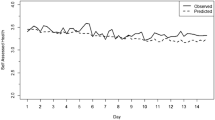Abstract
The relationship between the pace of life and coronary heart disease (CHD) was examined in a total of 36 small, medium, and large metropolitan areas across the United States. Four indicators of pace were observed: walking speed, articulation rate (talking speed), bank teller speed (work speed), and the proportion of individuals wearing watches (concern with clock time). Pace of life was strongly related to death rates from coronary heart disease both across cities and across regions of the country. This provides support, on a sociological level, for Wright's (1988) contention that time urgency is a toxic element of the Type A behavior pattern. It is proposed that individuals living in fast-paced cities may be more prone to unhealthy behaviors (e.g., cigarette smoking), which place them at a greater risk for CHD. The relationship among cities' temporal norms, Type A time urgency, and coronary heart disease is also discussed.
Similar content being viewed by others
References
Amato, P. R. (1983). The effects of urbanization on interpersonal behavior.J. Cross-Cult. Psychol. 14: 353–367.
Bohannan, P. (1980). Time, rhythm, and pace.Science 80(1): 18–20
Booth-Kewley, S., and Friedman, H. (1987). Psychological predictors of heart disease: A quantitative review.Psychol. Bull. 101: 343–362.
Bornstein, M. H. (1979). The pace of life: Revisited.Int. J. Psychol. 14: 83–90.
Bornstein, M. H., and Bornstein, H. (1976). The pace of life.Nature 259: 557–559.
Boyer, R., and Savageau, D. (1985).Places Rated Almanac (rev. ed.), Rand McNally, Chicago.
Christopher, R. C. (1983).The Japanese Mind, Tuttle, Tokyo.
Cohen, J. B., Syme, S. L., Jenkins, C. D., Kagan, A., and Zyzanski, S. J. (1975). The cultural context of type A behavior and the risk of CHD.Am. J. Epidemiol. 102: 434.
Eliot, R. S., and Buell, J. C. (1983). The role of the central nervous system in sudden cardiac death. In Dembroski, T. M., Schmidt, T., and Blunchen, G. (eds),Biobehavioral Bases of Coronary-Prone Behavior, Karger, New York.
Epstein, L., and Perkins, K. (1988). Smoking, stress, and coronary heart disease.J. Consult. Clin. Psychol. 56: 342–349.
Freedman, J., and Edwards, D. (1988). Time pressure, task performance, and enjoyment. In McGrath, J. E. (ed.),The Social Psychology of Time: New Perspectives, Sage, Newbury Park, CA, pp. 113–133.
Friedman, A. P., and Rosenman, R. H. (1974).Type A Behavior and Your Heart, Knopf, New York.
Haynes, S. G. (1989). Epidemiology and behavioral medicine: The usefulness of epidemiologic methods for etilogic studies. Paper presented at the annual meeting of The Society for Behavioral Medicine, San Francisco.
Hoch, I. (1976). City size effects, trends and policies.Science 193: 856–863.
Hoel, L. A. (1968). Pedestrian travel rates in central business districts.Traffic Eng. 38: 10–13.
Lauer, R. H. (1981).Temporal Man: The Meaning and Uses of Social Time, Praeger, New York.
Levine, R. (1988). The pace of life across cultures. In McGrath, J. E. (ed.),The Social Psychology of Time: New Perspective, Sage, Newbury Park, CA, pp. 39–62.
Levine, R., and Bartlett, K. (1984). Pace of life, punctuality and coronary heart disease in six countries.J. Cross-Cult. Psychol. 15: 233–255.
Levine, R., West, L., and Reis, H. (1980). Perceptions of time and punctuality in the United States and Brazil.J. Personal. Soc. Psychol. 38: 541–550.
Lowin, A., Hottes, J., Sander, B., and Bornstein, M. (1971). The pace of life and sensitivity to time in urban and rural settings: A preliminary study.J. Soc. Psychol. 83: 247–253.
Marmot, M. G., and Syme, S. (1976). Acculturation and coronary heart disease in Japanese-Americans.Am. J. Epidemiol. 104: 225–247.
Matthews, K. (1988). Coronary heart disease and Type A behaviors: Update on and alternative to the Booth-Kewley and Friedman (1987) quantitative review.Psychol. Bull. 104: 373–380.
Milgram, S. (1970). The experience of living in cities.Science 167: 1461–1468.
Rosenman, R. (1987) The impact of anxiety and non-anxiety in cardiovascular disorders. Paper presented at a conference on Applications of Individual Differences in Stress and Health Psychology, Winnipeg, Manitoba, Canada.
Smith, T., and Anderson, N. (1986). Models of personality and disease: An interactional approach to Type A behavior and cardiovascular risk.J. Personal. Soc. Psychol. 50: 1166–1173.
Smith, T., and Rhodewalt, F. (1986). On states, traits, and process: A transactional alternative to the individual difference assumptions in Type A behavior and physiological reactivity.J. Res. Personal. 20: 229–251.
U.S. Bureau of the Census (1984).Statistical Abstracts of the United States: 1985, Washington, DC.
U.S. Department of Health and Human Services (1986).Vital Statistics of the United States, 1981, Vol. II. Mortality, Holtsville, MD.
U.S. Department of Health and Human Services (1987). Regional variation in smoking prevalence and cessation: Behavioral risk factor surveillance, 1986.Morbid. Mortal. Week. Rep. 36: 751–754.
Werner, C. M., Altman, I., and Oxley, D. (1985). Temporal aspects of homes: A transactional perspective. In Altman, I., and Werner, C. M. (eds.),Home Environments, Vol. 8. Human Behavior and Environment: Advances in Theory and Research, Plenum, New York, pp. 1–32.
Wright, H. F. (1961). The impact of anxiety and non-anxiety in cardiovascular disorders. Paper presented at a conference on Applications of Individual Differences in Stress and Health Psychology, Winnipeg, Manitoba, Canada.
Wright, L. (1988). The Type A behavior pattern and coronary artery disease.Am. Psychol. 43(1): 2–14.
Author information
Authors and Affiliations
Rights and permissions
About this article
Cite this article
Levine, R.V., Lynch, K., Miyake, K. et al. The Type A city: Coronary heart disease and the pace of life. J Behav Med 12, 509–524 (1989). https://doi.org/10.1007/BF00844822
Accepted:
Issue Date:
DOI: https://doi.org/10.1007/BF00844822




